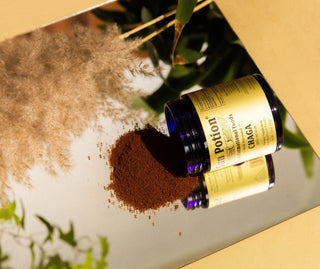Our Relationship with Anxiety, a note from Amrit
Anxiety is something that so many of us deal with daily. It may be as small as an increased heart-rate or butterflies in the stomach to a full-fledged, debilitating panic attack. Whether you fall at the beginning, the end or somewhere in between, finding tools to help heal and cope can be life-changing. It can take you from living in a constant state of fight or flight (sympathetic nervous system) which taxes your nervous system, adrenals, and weakens your immune system, to feeling stronger, more stable and more in control of your body.
Before diving into adaptogens, I want to give the disclaimer that healing and changing your relationship to with anxiety is a journey and the journey is not linear. Everybody’s story is different, and I am sharing my own experience with both myself and my clients. While adaptogens are an amazing tool, they are not a cure-all and work best in conjunction with other conscious and healthy lifestyle choices. As an anxiety coach, I recommend using many tools together to give yourself the support you need to not only face your anxiety but also be able to recognize it at onset and diffuse it before it gets the better of you.
Adaptogens have played a huge role in my own anxiety journey, so let’s dive in!

My Favorite Adaptogens
Ashwagandha* is a traditional Ayurvedic herb that has been used for thousands of years as a nerve tonic. It is a Sanskrit word that translates to “the sweat of a horse.” It is named both for its strong smell as well as its ability to give you the strength and vigor of a stallion. Ashwagandha has been used for everything from stress and anxiety, inflammation, balancing hormones, to strengthening the lining of the uterus. This beautiful plant is known to energize and calm all at the same time, providing your body with what it needs at the moment. There have been many evidence-based studies done with Ashwagandha showing its powerful effect on stress and anxiety. It does this by lowering your cortisol levels and mimicking the inhibitory neurotransmitter for GABA. Traditionally it was combined with milk and honey to create a warming and grounding drink.
Now let’s talk about Reishi. I am frequently asked by clients “If I take one adaptogen, where should I start?” This honestly depends on each individual and what support they need for their bodies, but in general, I will usually say either Ashwagandha or Reishi. Reishi is a medicinal mushroom used for thousands of years in Traditional Chinese Medicine (TCM). It is also referred to as “Queen of the plants.” This amazing mushroom packs a gentle but powerful punch. It has a calming effect on the adrenal glands and nervous system. When we are stressed, we go into our sympathetic nervous system or our “fight or flight” mode. This stimulates the adrenal glands, raising your heart-rate, making you feel anxious. The thing is, we need this function if we are being chased by a hungry bear, but we aren’t meant to live in this state all day, every day. Reishi has been shown to lower the day to day stress on your body and keep you in a calmer, more zen space. I like to refer to it as yoga in a cup. This adaptogen's effects build in your system over time. I recommend starting with 1/8 teaspoon each day and building up to 1⁄2 tsp. as you see fit. I think it is always important to listen to your body and what it is asking.

Anxiety and depression have a tendency to go hand in hand. When we are feeling good in our bodies and minds, depression and anxiety can naturally ease. One of my favorite adaptogens for lifting your dopamine is Mucuna Pruriens. Also known as “the dopamine bean.” This bean is high in L-Dopa, the precursor to Dopamine. Dopamine is the feel-good chemical released in the brain that makes us feel happy. I find this magical bean to be especially helpful in combination with Reishi and/or Ashwagandha. Seasonal Affective Disorder (SAD) is a real thing (believe me, I live in Portland, OR). In my experience, I find that this time of year (depending on where you live) a deeper level of sadness or depression can set in. When we feel unmotivated, we run through all the things we “should” be doing in our head and when we aren’t doing them, the anxiety sets in. This is where Mucuna can be helpful. It can give your body and mind that little extra boost you need to get you feeling good. It has also been shown in studies to reduce anxiety.
So now that you have a resource for adaptogens that assist in anxiety relief, how do you use them? All adaptogens can be found in a tincture form or as a powdered extract. I prefer them as powdered extracts as I am able to combine them as my body needs in beautiful lattes, chocolates, puddings, etc. No one form is better than another, it is just personal preference.
Adaptogenic Lavender Latte
I created a beautiful "SOS" latte that combines all three of the adaptogens and some other calming herbs to help you feel calm and centered in your body.
Here is the recipe!
Ingredients1⁄2 cup filtered water 1⁄2 cup nut milk (I prefer homemade) 1 tsp. culinary lavender flowers 1⁄2 tsp. Ashwagandha 1⁄2 tsp. Reishi 1⁄2 tsp. Mucuna Pruriens 1 tsp. ghee or coconut oil 1 tsp. honey |
MethodIn a saucepan combine the water, milk and lavender flowers over medium heat Heat until steam begins to rise from the mixture Remove from heat and let sit for 5 minutes Strain the mixture into a high-speed blender Add the adaptogens, ghee, and honey (honey has also been shown to be calming to the nervous system) Blend on high until combined and frothy Pour into your favorite mug (this is a very important step) and sip mindfully while taking deep belly breaths |
A quick breathwork exercise:
When I am feeling anxious, no matter where I am on the scale, I do this breathwork technique for 1-11 minutes. Find yourself a quiet place, close your eyes and block your right nostril with your thumb. Begin to deeply inhale and exhale through your left nostril. Feel the breath fill your belly and feel your belly contract as you exhale.
You should start to feel calm within just a few breath cycles.
This is called left nostril breathing, potential benefits may include...
• Activating the Ida Nerve Ending in the left nostril with leads to calmness and
relaxation
• Lowering blood pressure
• Lowering heart rate
• Increasing sensitivity
Living with anxiety can be exhausting, but there are things that you can do to empower yourself and lead yourself to a calmer, less stressful life. It doesn’t mean that it will never sneak back in from time to time, but I have found that a strong self-care practice, adaptogens, breathwork, movement, and mindfulness can lead you to a path of healing and compassion for yourself.
Images courtesy of Amrit-Sadhana Khalsa




















Melissa
I would also like to know the answer to Paule’s question above, as I have also had my uterus removed and bladder lifted.
Paule
I am scheduled to have a hysterectomy and bladder lifting in one month.Without the uterus can I use the adaptagins you mentioned above article?
Sadh Bakshish
Very well written, informative… and recipes!